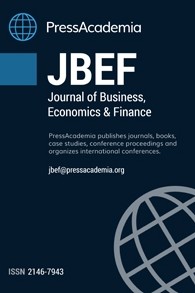FOREIGN OWNERSHIP AND CORPORATE PERFORMANCE IN TURKEY
FOREIGN OWNERSHIP AND CORPORATE PERFORMANCE IN TURKEY
Foreign ownership, Corporate performance Turkey,
___
- • Akimova, I., and G. Schwödiauer. (2004), “Ownership Structure, Corporate Governance and Enterprise Performance: Empirical Results from Ukraine”, International Advances in Economic Research, 10(1), 28-42.
- • Aitken, B., and A. Harrison. (1999), “Do Domestic Firms Benefit from Direct Foreign Investment? Evidence from Venezuela,” The American Economic Review, 89(3), 605-617.
- • Aydın, N., M. Sayım, and A. Yalama. (2007), “Foreign Ownership and Firm Performance: Evidence from Turkey”, International Research Journal of Finance and Economics, 11, 103-110
- • Azzama, I., J. Fouadb, and D. K. Ghosch. (2013), “Foreign Ownership and Financial Performance: Evidence from Egypt,” International Journal of Business, 18(3).
- • Barbosa, N., and H. Louri. (2005), “Corporate Performance: Does Ownership Matter? Comparison of Foreign and Domestic owned Firms in Greece and Portugal”, Review of Industrial Organization, 27, 73-102.
- • Blomström, M., and F. Sjöholm. (1999), “Technology Transfers and Spillovers: Does Local Participation with Multinationals Matter?”, European Economic Review, 43, 915-23.
- • Bastı, E. and N. Bayyurt. (2008), “Efficiency Performance of Foreign-Owned Firms in Turkey”, Transformation in Business&Economics, Supplement C, Vol. 7.
- • Bastı, E., N. Bayyurt, and A. Akın, 2011, “A Comparative Performance Analysis of Foreign and Domestic Manufacturing Companies in Turkey”, European Journal of Economics and Political Studies, (2).
- • Chhibber, P.K., and S.K. Majumdar. (1999), “Foreign Ownership and Profitability: Property Rights, Control, and the Performance of firms in Indian Industry,” Journal of Law and Economics, 42(1), 209 - 238.
- • Doms, M., and J.B. Jensen. (1995), “Comparing Wages, Skills, and Productivity between Domestically and Foreign-Owned Manufacturing Establishments in the United States,” in Robert E. Baldwin, Robert E. Lipsey, and J. David Richardson (eds.), Geography and Ownership as Bases for Economic Accounting, Chicago, IL: University of Chicago Press.
- • Douma S., Rejie G., Rezaul K. (2006), “Foreign and Domestic Ownership, Business Groups, and Firm Performance: Evidence From a Large Emerging Market”Strategic ManagementJournal, 27, 637-657.
- • Erdoğan, A. İ. (2011), “Foreign-Owned Firms and Domestically-Owned Firms In Turkey: An Analysis of the Differentiating Characteristics”, Journal of Money, Investment and Banking Issue 19.
- • Greenway D., A. Guariglia, and Z. Yu. (2014), “The More the Better? Foreign Ownership and Corporate Performance in China”, The European Journal of Finance, (20): 681-702.
- • Karatas, A. (2005), “Performance of Direct Foreign Investments in Turkey”, Ankara: Capital Markets Board of Turkey Publication, No: 185.
- • Kimura, F. and K. Kiyota. (2007), “Foreign-Owned versus DomesticallyOwned Firms: Economic Performance in Japan,” Review of Development Economics 11:31-48.
- • Taymaz, E. and S. Özler. (2007), “Foreign Ownership, Competition, and Survival Dynamics”, Review of Industrial Organization, (31): 23-42.
- Yayın Aralığı: Yılda 4 Sayı
- Başlangıç: 2012
- Yayıncı: PressAcademia
Mehtap Ozsahin, Melike Kivanc Sudak
EXTERNAL DEBT AND ECONOMIC GROWTH: NEW EVIDENCE FOR AN OLD DEBATE
FOREIGN OWNERSHIP AND CORPORATE PERFORMANCE IN TURKEY
WHAT IS WRONG WITH PRIVATE SHOPPING SITES? – EVIDENCE FROM TURKEY
Gulmus Boruhan, Pervin Ersoy, Isik Ozge Yumurtaci
Catherine Wahito Kahuria, Gabriel Waweru
ELECTRICITY SUPPLIER SWITCHING: A CONCEPTUAL MODEL BASED ON MIGRATION THEORY
EFFECTS OF OPERATIONAL COSTS ON LENDING INTEREST RATES OF COMMERCIAL BANKS
Elizabeth Kananu, Jackson Ireri
THE COMPARISION OF THE FINANCIAL FAILURE WITH ARTIFICIAL NEURAL NETWORK AND LOGIT MODELS
